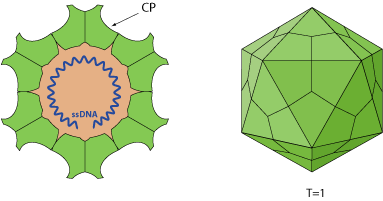Brevihamaparvovirus (taxid:2733230)
Former names: Brevidensovirus, Contravirus

VIRION

Non-enveloped, round, T=1 icosahedral symmetry, 21-22 nm in diameter. The capsid consists of 60 copies of CP protein.
GENOME
Linear, ssDNA genome of about 4kb in size, with long inverted terminal repeats. Both positive and negative strands are encapsidated, but a majority of strands are of negative polarity (85%).
The genome is replicated through rolling-hairpin mechanism.
GENE EXPRESSION
Host proteins transcribe the genomes into mRNAs.
ENZYMES
REPLICATION
NUCLEAR
- Attachement to host receptors initiates clathrin-mediated endocytosis of the virion into the host cell.
- The virion penetrates into the cytoplasm via permeabilization of host endosomal membrane.
- Microtubular transport of the virion toward the nucleus.
- The viral ssDNA genome penetrates into the nucleus.
- The ssDNA is converted into dsDNA by cellular proteins.
- dsDNA transcription gives rise to viral mRNAs when host cell enters S phase and translated to produce viral proteins.
- Replication occurs through rolling-hairpin mechanism, with NS1 endonuclease binding covalently to the 5' genomic end.
- Individual ssDNA genomes are excised from replication concatemers by a process called junction resolution.
- These newly synthesized ssDNA can either
a) be converted to dsDNA and serve as a template for transcription/replication
b) be encapsidated to form new virions that are released by cell lysis.
Host-virus interaction
Apoptosis modulation
IHHNV induces apoptosis
and caspases activation in p53-deficient cells

 .
.
Matching UniProtKB/Swiss-Prot entries
(all links/actions below point to uniprot.org website)5 entries grouped by strain
3 entries
Aedes albopictus densovirus (isolate Boublik/1994) (AalDNV) reference strain
2 entries
Aedes densonucleosis virus (strain GKV 002 002) (Aedes densovirus)
Aedes aegypti densovirus 2 taxid:1513196
| Protein | ModelArchive |
| Capsid protein | ma-jd-viral-53335 |
| Nonstructural protein 1 | ma-jd-viral-46229 |
| Nonstructural protein 2 | ma-jd-viral-56724 |
